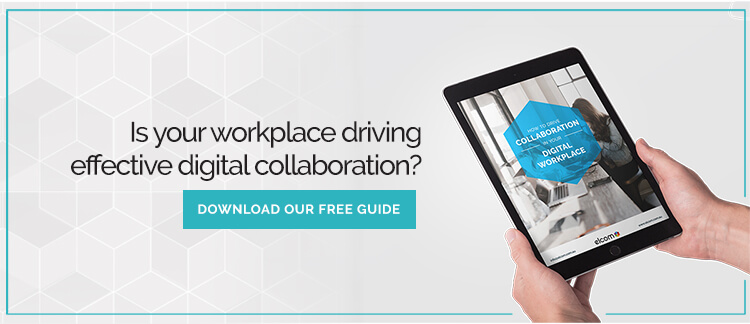Employee collaboration is a business concept which underlines how processes are carried out within organisations. Without the proper tools and strategies, employee collaboration can be hard to foster in the workplace.
Over the past two years we've posted a number of articles and blog posts discussing the topic of effectively collaborating with others.
In this post we've put together an overview, with links through to the articles and posts.
Why Employee Collaboration is Key to Success
One of the most popular posts on the blog has been our discussion on the importance of collaboration in the workplace.
We discussed the fact that employee collaboration involves:
- The knowledge sharing which produces a more educated and skillful workforce (more information on what is knowledge management and why its important, here.)
- more efficiently completing tasks
- employee satisfaction, feeling of value and engagement in the community
- greater understanding of what the company does and how
- cross-company skills can be pooled
- employees can be educated by each other and by bosses
- working from home or from remote locations becomes easier

How is Collaboration Implemented Successfully?
We've also covered a number of the most popular enterprise collaboration tools and strategies used by companies to achieve collaboration. These include:
- intranets with social elements including team workspaces
- cloud services
- enterprise social networking
- document and video collaboration tools
- mobile applications designed for organisations
- IoT and wearable tech (which will, in the future, become an important part of collaboration between staff)
All of these engagement solutions rely of course on communication and effective technology and infrastructure to facilitate teamwork. When it comes to improving collaboration strategy, the above mentioned tools should be optimised and used correctly, otherwise a company’s employee engagement strategy will not reach its full potential. On the blog, we outline the main reasons why collaboration might fail:
- unclear goals
- lack of transparent decision-making process
- management not sticking to the outlined processes
The #1 Workplace Collaboration platform: Intranets
Our collaboration blog posts are largely focused on the importance of intranets in facilitating collaboration and driving employee engagement in a company.
For instance, our organisational culture and the intranet blog post explains the need for clear goal definitions and management of intranets to ensure ongoing development. Intranets should be regularly optimised in order to encourage productivity and morale. Ongoing improvements to a company intranet drives engagement and productivity and in turn, increases profit.
It's no wonder that intranets are the backbone of online communication within a business and help improve workplace collaboration.
- reduced costs
- improved interdepartmental relationships and working practices
- improved relationships with customers and suppliers
- employees feeling more valued
- transparency within the organisation
One of the largest employee trends in recent years is remote working, which has been on the rise thanks largely to enabling technology such as mobile, faster internet speeds and more powerful and engaging intranets. Successful intranets designed with remote workers in mind include online collaboration tools such as IM, wikis, message boards and profiles as well as shared workspaces which allow for good communication.
Some believe intranets are outdated platforms that have no place in business, however, new cloud and other technologies mean that community-centric and CMS platforms are more accessible and relevant than ever before. Read about modern intranet uses in our post, the rebirth of the intranet.
Social Networking at Work
Another topic discussed at length on the Elcom blog is the use of social intranet tools to boost engagement and collaboration. As we already know, engagement and productivity are linked when it comes to intranets. Modern intranet platforms include a wide array of social tools for employee use. These, as well as other tools (blogging, forums, wikis, social feeds, Q&A sections), help to establish a working intranet which provides many benefits to an organisation. You can expect benefits like:
- sharing of ideas
- connecting with more people
- reducing email
- increasing user generated content
- reducing meetings
Enterprise Social Networking is also making waves as a method for improved collaboration and productivity in the workforce. This post on what you need to know about Enterprise Social Networking outlines how ESNs use social software to improve three key areas of business:
- Collaboration – employees can share and distribute information with others including, documents, email, IM, online meetings, video conferencing, webinars, screen sharing
- Content – documents, video, images can all be shared through the social network
- Communication – search engines, bookmarking, news feeds, profiles, commenting, photo-sharing, favourites and ratings
Another blog post, improving connection, communication and collaboration, sums up how intranet and social tools can enable collaboration in an organisation. By implementing and optimising intranets and social networking to suit your organisation’s needs you can not only expect increased revenue, but also higher employee morale, better customer service and an overall sense of engagement.
See all of our blog posts about improving employee collaboration in your organisation here.
Master Online Collaboration Guide
Need more information on mastering collaboration in your digital workplace? Our online collaboration guide outlines the information on establishing better collaboration procedures and optimising your existing ones. You will find key insights into common collaboration challenges and strategies and tools to overcome these. Along the way we'll also look at how to measure effectiveness.
